Reading Time : 1 Mins
Trends To Watch: Major Fintech Trends In 2024 And Beyond
I write about fintech, data, and everything around it
Over the past few years, Fintech services have delivered exceptional convenience and cost-effective access to millions of consumers.
The growth in digital banking is showing no signs of slowing down. Convenience, speed and security aren’t just extra benefits in consumers’ minds anymore.
This blog covers all the major technological trends for 2024 and beyond that you would not want to skip.
Let’s get started.
1. Instant Payment with International Interoperability
The concept of Instant Payment has become highly important in both consumer and B2B payment areas, where settlement time has really been a challenge earlier.
The term “Instant Payment” refers to the ability to make payments within a matter of seconds, which in turn will be highly beneficial for both parties throughout the payment landscape.
As a result, Instant payments have become an integral part of both financial institutions and regulators, driven by key success stories in early deployments.
- The SEPA (Single Euro Payments Area) scheme in the EU has significantly brought down settlement times, and the SEPA Instant Credit Transfer Scheme further reduced it.
- In SEPA Instant, the payment will be received in a matter of 10 seconds, which is dramatically faster than traditional methods. However, still much more work needs to be done.
- Adding, the US Federal Reserve has announced FedNow. This service will process individual credit transfers valued at $25000 or less within seconds. But this service will not launch until 2024.
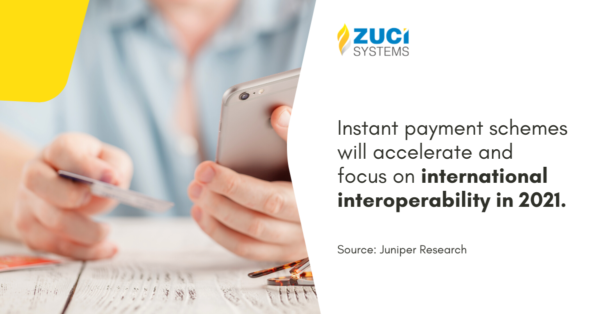
Why is this important to banking & financial services and what should they be prepared for?
Instant payment schemes will accelerate and focus on international interoperability in 2024, enabled by standardization with ISO 20022 and cross-border schemes. This will allow banks and financial services to upgrade to:
- Faster and simpler accounts payable/receivable processes
- Less complicated B2B payment systems
- Increased payment volume for payment processors
In order to achieve these benefits, banks will need to update their systems because the whole chain needs to support the instantaneousness of payments.
2. Open Banking for Digital-only Banks
In recent years, Digital-only banks have emerged in numerous markets by focusing on disrupting the single elements of the banking experience. This has left digital banks limited in scope and not widely utilized as main accounts.
What are Digital-only banks?
Digital banking or Digital-only bank is part of the broader context for moving to online banking, where banking services are delivered over the Internet.
But Open Banking is enabling a change to this by providing users with services such as insurance, mortgages, credit, and much more at one single digital bank provider.
What is Open Banking?
Open Banking is a model in which the banking data is shared between two or more unaffiliated parties to deliver enhanced marketplace capabilities.
Open Banking APIs mean that the Digital-only banks do not necessarily have to offer these other services themselves, but it can be added from third parties via APIs. Therefore, this provides a significant appeal to their brand by providing complete banking services without having to do an enormous amount of work themselves from the get-go.
Starling Bank in the UK is one such example of an API-based marketplace for personal and business customers, offering further financial services.
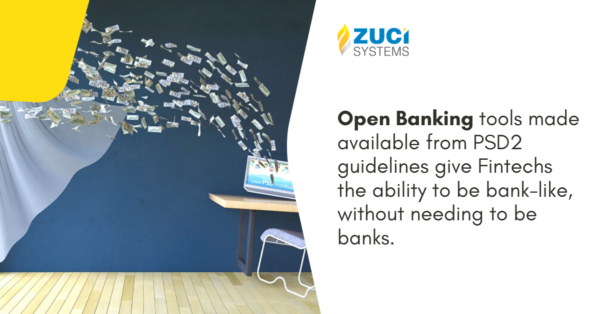
Why is this important to banking & financial services and what should they be prepared for?
Open Banking has become relatively well established in Europe due to the changes under PSD2, meaning the customers are now more open to shared access.
As a result, Digital-only banks will evolve into full-bundle bank offerings by increasing their value proposition significantly. This will create:
- Additional impetus for digital transformation at traditional banks
- Higher traction in the digital-only banking space, with users moving all transactions to these accounts
Therefore, traditional banks should launch digital-only brands of their own, such as Bo from NatWest, to defend and withstand the market share.
3. Consolidation of Challenger Banks
Challenger banks have been an important new element in the financial services ecosystem in the last few years.
What is a Challenger Bank?
Challenger Banks, for the most part, is exclusively mobile, who have their own charter, and they are challenging the status quo of the incumbent banks in the marketplace. For example, N26 is a mobile-only bank.
However, despite nine challenger banks reaching Unicorn status & over $1 billion of funding and reaching millions of customers worldwide, the outlook for these banks is a little shaky at the moment.
Adding several challenger banks have made it clear that they are still prioritizing growth over profitability, which will deter investors.
Back in July of 2019, following a fresh round of investment, N26 co-founder Maximilian Tayenthal told the Financial Times that “In all honesty, profitability is not one of our core metrics. We want to build a global financial services company… in the years to come, we won’t see profitability; we’re not aiming to reach profitability.”
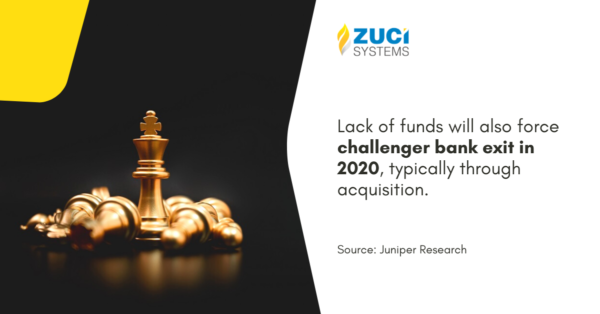
Why is this important to banking & financial services and what should they be prepared for?
The current year has a variety of different market trends converge on challenger banks. Mainly due to Covid-19, with rising defaulters, which in turn dropped the profitability further. Adding, the capital to fund ongoing investment in technology-focused companies is drying up as part of the ‘techlash.’
Moreover, several traditional banks have recently launched their own digital-only offerings, showing the desire to compete with digital-only banks.
We expect 2024 to be a key year for the consolidation of challenger banks because of a broader trend in the technology investment market. Juniper Research report predicts, “lack of funds will also force challenger bank exit in 2020, typically through acquisition.”
One way or the other, most challenger banking start-ups will be in a better competitive position with larger banks as partners, and vice versa. With the number of partnership announcements made around Money2020 Europe, the industry is clearly turning to maturity and scalability through collaboration.
4. Tech Firms Move into Banking
Tech firms like Apple, Google & Samsung have been providing payment services for several years now, and few have started to coalesce to accelerate their financial services movement.
The primary reason is the decreasing financial brand loyalty, due to open banking, which has loosened the rope that banks have on their customer data. Adding, many countries are mandating a streamlined switching service to move from one bank to another much more quickly.
Most importantly, banks have limited ability to retain their users compared to what they are traditionally used to. At the same time, technology companies have always had much more success in developing in a closed ecosystem. And they are now looking to bring finance under their banner.
Why is this important to banking & financial services and what should they be prepared for?
With Apple Card showing its prominence. And Google, Stripe, and PayPal preparing to start, or expand banking and payment-related offerings, it is evident that the industry is already shaken.
Moreover, the Open Banking tools made available from PSD2 guidelines give these companies the ability to be bank-like, without needing to be banks.
We think that the partnership between banks and tech companies are more likely than tech companies outright becoming banks.
Instead of viewing big tech companies as a threat, banking and financial institutions should embrace partnerships and collaboration with them.
5. Contactless Cards to Reach scale in the US
Following the successful transition from magstripe to EMV (Europay, MasterCard, and Visa) cards, the US’s next area for significant growth is contactless payment cards.
Contactless acceptance has risen at POS (Point-of-Sale), with card issuer support growing rapidly. The EMV rollout means that much of the POS infrastructure in the US already supports contactless in principle, and thus a rollout of cards will be smoother and swifter.
Adding, many of the major card issuers in the US have now added contactless functionality for their cardholders.
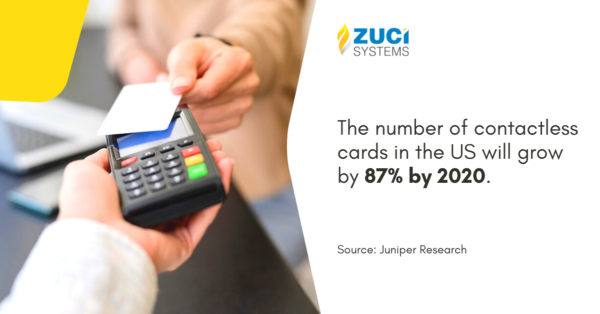
Why is this important to banking & financial services and what should they be prepared for?
The cost of issuing contactless cards has declined significantly as a result of major card issuers sharing economies of scale. In 2019 US banks like Bank of America, Wells Fargo & Chase, and credit card providers like American Express started issuing contactless cards.
Also, an increasing number of contactless-enabled payment cards are being introduced by several major banks and credit card issuers. Visa has already conducted an extensive advertising campaign designed to raise awareness of contactless payment cards and has set a goal of 300 million cards by 2020.
According to Juniper Research, the number of contactless cards in the US will grow by 87% by 2019-2020.
This will enable a greater throughput of transactions at POS. Moreover, contactless transactions provide a speed advantage over Chip & PIN transactions, leading to reduced POS payment times and superior customer satisfaction which banks and financial institutions should not skip.
6. Blockchain will disrupt International Money Transfer
Traditional money transfer solutions have been problematic in both the B2B and P2P areas, plagued by slow transfer times and high costs.
The clearing firms involved in the transactions have independent processing systems. Each party involved in that process will keep their own copy of that record of a given transaction, making it stringent.
The lack of standardization between these bodies and correspondent banks means that costs are high, and settlement periods are longer. But, thanks to Blockchain.
Blockchain has the potential to solve these challenges by offering faster transaction times, more transparency, and lower costs, changing the money transfer equation.
Why is this important to banking & financial services and what should they be prepared for?
In the last year, Blockchain has emerged as a promising approach in the money transfer field, backed by Visa (B2B Connect), IBM (Blockchain World Wire), and Ripple (RippleNet). And all the three being fairly different from one another.
These players have also announced several partnerships with traditional money transfer operators and IT providers, providing necessary infrastructure, showing signs of momentum.
In the future, Blockchain will become a viable technological solution in money transfer. And, banks & traditional money transfer operators will be able to use Blockchain to improve services, enabling them to retain market share. As a result, customers will benefit from improved settlement times and easier processes.
7. Cyber-Security will be a top priority
Banks have always been at the forefront of enterprise cybersecurity. Their enormous stores of cash and consumer data have made them a top target for hackers, and the threat of financial losses, regulatory consequences, and reputational damage has spurred them to innovate and accelerate the field of cybersecurity.
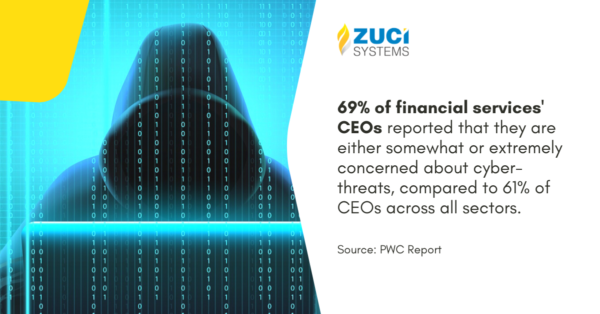
Financial services executives are already depressingly familiar and aware of the impact of cyber-threats on the industry.
According to the PWC report, “69% of financial services’ CEOs reported that they are either somewhat or extremely concerned about cyber-threats, compared to 61% of CEOs across all sectors.”
Why is this important to banking & financial services and what should they be prepared for?
Cybersecurity has been of great importance in the financial sector. It becomes all the more necessary since the very foundation of banking lies in nurturing trust and credibility. Here are five reasons why cybersecurity is important in banking and why it should matter to you.
- Increase in third-party vendors support
- Rapid innovations and complex technologies
- A rise in cross-border data exchanges
- Heightened cross-border information security threats
- Greater use of mobile technologies by customers, including the rapid growth of the Internet of Things
Banks and financial institutions must leverage technologies like biometrics, credential management, restricted access, network monitoring, and intruders’ rapid isolation to secure digital platforms.
This becomes very important to gain the customer’s trust and loyalty in an industry where it matters the most.
Final Thoughts
As Financial Technologies keep innovating rapidly, disruption in the financial services industry is inevitable. It is high time for traditional financial institutions to rework their offerings from the inside out to meet customers’ expectations by upgrading or partnering with Financial Technology providers.
Zuci Systems is a digital organization focused on the craft of building software which we have perfected over the years. Zuci has worked with several financial institutions and helped them enhance their digital journey using technologies like Business Intelligence (BI), Analytics, Data Sciences, Machine Learning and Artificial Intelligence.
Frequently Asked Questions (FAQs):
1) How does fintech impact consumers?
Fintech impacts consumers by providing convenience through easy access to financial services via smartphones, improving accessibility to banking, credit, and investments for underserved populations, offering cost savings with lower fees and better rates than traditional banks, delivering personalized financial advice and products, and ensuring data protection with advanced security measures.
2) What is the fintech industry outlook for 2024?
The fintech industry outlook for 2024 is positive, with expectations of increased adoption by consumers and businesses, regulatory frameworks evolving to support innovation, advancements in technologies such as AI and blockchain driving new solutions, global expansion into new markets, and continued strong investment from venture capital and private equity sources fueling growth and development.
3) What is the trend in fintech industry?
Key trends in the fintech industry include the rise of digital payments like contactless and mobile transactions, growing adoption of blockchain technology and cryptocurrencies, the use of AI and machine learning for fraud detection and personalized services, the development of RegTech solutions to streamline regulatory compliance, and the promotion of open banking initiatives that enhance transparency and competition.
4) What is fintech and its impact on financial services?
Fintech refers to the integration of technology into financial services, leading to a more user-friendly and efficient customer experience, fostering innovation and competition that result in new financial products and lower costs, promoting financial inclusion by providing access to underserved populations, increasing operational efficiency by reducing costs, and enabling data-driven decisions for better credit assessments and personalized products.
5) What is the role of fintech in the economy?
Fintech drives economic growth by making financial services more efficient and accessible, creates new jobs in the technology and finance sectors, promotes innovation with the development of new financial products, improves efficiency by lowering costs for businesses and consumers, and extends financial services to underserved populations, fostering greater economic participation and reducing poverty levels.
Read Next:
Related Posts





















